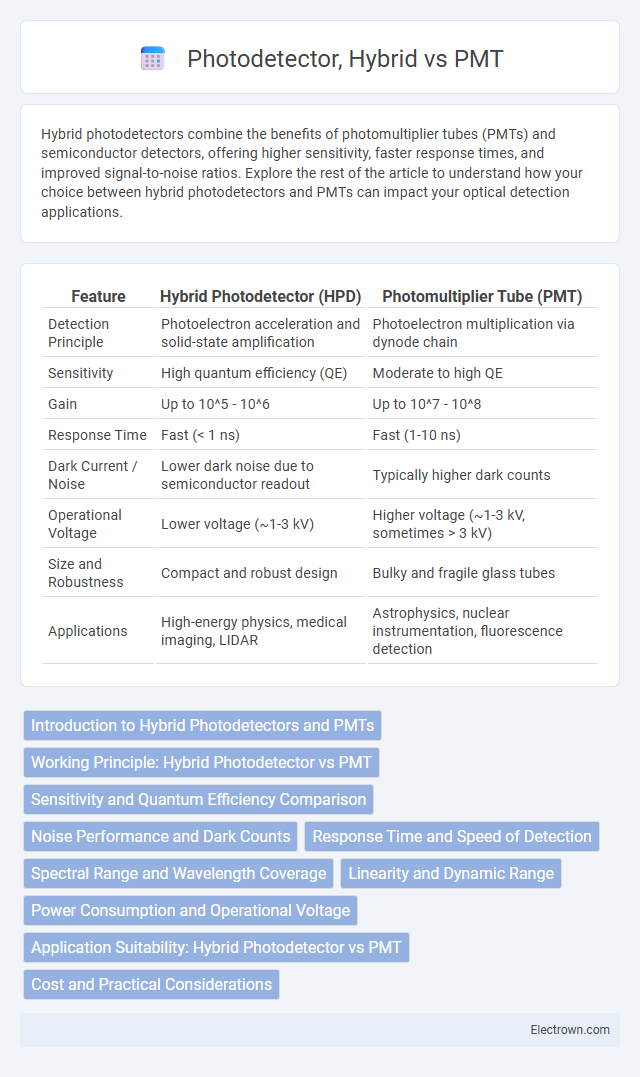Hybrid photodetectors combine the benefits of photomultiplier tubes (PMTs) and semiconductor detectors, offering higher sensitivity, faster response times, and improved signal-to-noise ratios. Explore the rest of the article to understand how your choice between hybrid photodetectors and PMTs can impact your optical detection applications.
Table of Comparison
| Feature | Hybrid Photodetector (HPD) | Photomultiplier Tube (PMT) |
|---|---|---|
| Detection Principle | Photoelectron acceleration and solid-state amplification | Photoelectron multiplication via dynode chain |
| Sensitivity | High quantum efficiency (QE) | Moderate to high QE |
| Gain | Up to 10^5 - 10^6 | Up to 10^7 - 10^8 |
| Response Time | Fast (< 1 ns) | Fast (1-10 ns) |
| Dark Current / Noise | Lower dark noise due to semiconductor readout | Typically higher dark counts |
| Operational Voltage | Lower voltage (~1-3 kV) | Higher voltage (~1-3 kV, sometimes > 3 kV) |
| Size and Robustness | Compact and robust design | Bulky and fragile glass tubes |
| Applications | High-energy physics, medical imaging, LIDAR | Astrophysics, nuclear instrumentation, fluorescence detection |
Introduction to Hybrid Photodetectors and PMTs
Hybrid photodetectors (HPDs) combine the high gain and low noise characteristics of photomultiplier tubes (PMTs) with the linearity and compactness of semiconductor devices, enabling advanced photon detection performance. Photomultiplier tubes utilize a vacuum tube structure with a photocathode and dynodes to amplify photoelectrons through secondary emission, providing excellent sensitivity and fast response times. HPDs offer enhanced quantum efficiency and improved dynamic range over traditional PMTs, making them ideal for applications in high-energy physics, medical imaging, and optical communication.
Working Principle: Hybrid Photodetector vs PMT
Hybrid photodetectors combine a photodiode with an avalanche photodiode or a semiconductor amplifier to convert photons into an electrical signal with enhanced quantum efficiency and reduced noise. Photomultiplier tubes (PMTs) utilize a photocathode to emit electrons via the photoelectric effect, which are then multiplied through a series of dynodes to generate a measurable current. Your choice between these devices depends on factors like sensitivity, gain, and application-specific requirements in photon detection.
Sensitivity and Quantum Efficiency Comparison
Hybrid photodetectors (HPDs) offer higher sensitivity than traditional photomultiplier tubes (PMTs) due to their ability to combine a photocathode with a semiconductor avalanche diode, resulting in lower noise and better signal-to-noise ratios. Quantum efficiency (QE) in HPDs typically exceeds that of PMTs, often reaching values above 40%, whereas PMTs generally exhibit QE around 20-30%, enhancing photon detection capabilities in low-light conditions. This increased sensitivity and QE make HPDs more suitable for applications requiring precise low-intensity light measurements, such as high-energy physics and biomedical imaging.
Noise Performance and Dark Counts
Hybrid photodetectors (HPDs) exhibit significantly lower noise performance and reduced dark counts compared to traditional photomultiplier tubes (PMTs), resulting in enhanced signal fidelity. HPDs benefit from a combination of semiconductor and vacuum tube technologies, which minimizes statistical noise and thermionic emission that typically increase dark counts in PMTs. This improved noise characteristic makes HPDs highly suitable for low-light detection applications where high sensitivity and low background noise are critical.
Response Time and Speed of Detection
Hybrid photodetectors (HPDs) exhibit significantly faster response times compared to photomultiplier tubes (PMTs), typically achieving nanosecond-scale pulse widths due to their efficient electron multiplication mechanism. HPDs combine a semiconductor diode with a vacuum tube, enabling rapid charge collection and reduced transit time spread, resulting in superior speed of detection. In contrast, PMTs rely on cascaded dynode amplification, which introduces longer delay and pulse broadening, making them slower in high-speed photon counting applications.
Spectral Range and Wavelength Coverage
Hybrid photodetectors (HPDs) typically offer a broader spectral range compared to photomultiplier tubes (PMTs), covering wavelengths from ultraviolet (UV) to near-infrared (NIR) regions, often spanning 300 nm to 900 nm or beyond. PMTs excel in the ultraviolet to visible spectrum, generally providing high sensitivity between 160 nm and 650 nm but with limited efficiency in the near-infrared range. This extended wavelength coverage of HPDs makes them preferable for applications requiring detection across a wide spectral range, including advanced spectroscopy and biomedical imaging.
Linearity and Dynamic Range
Hybrid photodetectors (HPDs) exhibit superior linearity and a wider dynamic range compared to photomultiplier tubes (PMTs), making them ideal for applications requiring precise light intensity measurements across varying scales. PMTs often suffer from saturation effects at higher photon rates, limiting their effective dynamic range and causing non-linear responses. Your choice of detector should consider HPDs when accurate quantification over broad intensity levels is critical for optimal performance.
Power Consumption and Operational Voltage
Hybrid photodetectors (HPDs) generally consume less power than photomultiplier tubes (PMTs), making them more energy-efficient for sustained operation. HPDs operate at lower voltages, typically in the range of a few hundred volts, whereas PMTs require high operational voltages often exceeding 1,000 volts, increasing the complexity and safety considerations in your system design. Choosing HPDs can lead to reduced power supply demands and simplify voltage regulation compared to PMTs.
Application Suitability: Hybrid Photodetector vs PMT
Hybrid photodetectors (HPDs) excel in high-sensitivity applications requiring fast timing and low noise, making them ideal for medical imaging, particle physics, and astrophysics. Photomultiplier tubes (PMTs) offer superior gain and photon detection efficiency in low-light environments, commonly used in fluorescence spectroscopy, nuclear medicine, and environmental monitoring. The choice between HPDs and PMTs hinges on specific application demands such as temporal resolution, dynamic range, and operational conditions.
Cost and Practical Considerations
Hybrid photodetectors (HPDs) generally offer a higher initial cost than photomultiplier tubes (PMTs) but provide enhanced durability and longer operational lifespan, reducing maintenance expenses over time. HPDs operate at lower voltages and are less sensitive to magnetic fields, which simplifies system integration and safety requirements compared to PMTs. For applications where budget constraints and ease of replacement dominate, PMTs remain favorable due to their established technology and lower upfront investment.
Hybrid photodetector vs PMT Infographic

 electrown.com
electrown.com